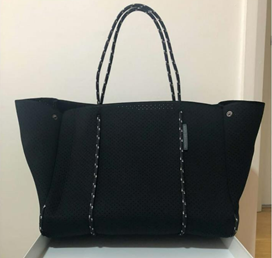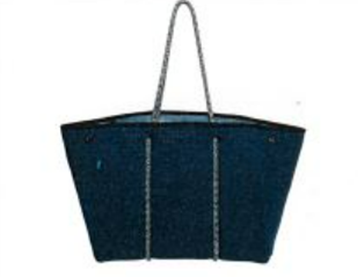Australian designer State of Escape has failed in its attempt to overturn the finding that its neoprene tote bag is not a "work of artistic craftsmanship" with the consequence that it is not protected under Australian copyright law.
In upholding the decision of the primary judge Justice Davies, the Full Federal Court in State of Escape Accessories Pty Limited v Schwartz [2022] FCAFC 63 held that the design of State of Escape's neoprene tote bag was substantially constrained by function. The decision helpfully illustrates the guiding principles relevant to determining whether something is or is not a work of artistic craftsmanship.
Copyright and design overlap
In Australia, generally works may be protected either as artistic works under the Copyright Act or as registered designs under the Designs Act but not both simultaneously. One important difference between the two regimes is that the Designs Act affords an owner of a registered design protection for up to 10 years from the date of application for the registered design. In contrast, protection of an artistic work under the Copyright Act does not require the design to be registered, and protection can last for up to 70 years after the year in which the author or creator dies.
Where works are to be mass produced, creators are not given free choice as to which regime they wish to govern their works. Generally in such circumstances, design protection will be the only viable option. This is because the Copyright Act provides a defence to copyright infringement in an artistic work where a corresponding unregistered design has been embodied in a product and applied industrially. For example, a designer will not be able to restrain competitors from creating 3D works form their 2D designs if they have licensed the embodiment of the artistic work on which they rely in a three-dimensional product of which more than 50 articles have been made.
However, that defence to copyright infringement does not apply if the artistic work is a "work of artistic craftsmanship".
The guiding principles for determining whether an article is a work of artistic craftsmanship were set out by the High Court in Burge v Swarbrick [2007] HCA 17, a decision concerning the reproduction of a hand-crafted full-scale model of the hull and deck sections of a yacht. Those principles in effect guide a consideration as to the extent to which the article's artistic expression, in its form, is unconstrained by functional considerations. This recent decision illustrates the application of those principles to a tote bag.
Background to the bag dispute
In 2013, State of Escape designed a tote bag made using perforated neoprene and featuring sailing rope wrapped around the body and base of the bag as well as being used for the bag's handles (Escape Bag). An image of the Escape Bag appears below.

In the first instance proceedings, State of Escape alleged that certain neoprene bags designed and sold by retailer Chuchka infringed State of Escape's copyright in its Escape Bag. An image of one the bags sold by Chuchka is pictured below.

Relevantly, State of Escape did not have a registered design for its Escape Bag. Given that its design had been applied to more than 50 articles, in order for there to be any copyright infringement, it was necessary for State of Escape to first establish that its design was a "work of artistic craftsmanship" and therefore a work in which copyright subsists.
Ultimately, the primary judge Justice Davies found that notwithstanding its aesthetic and design qualities, copyright did not subsist in the Escape Bag since it was not a "work of artistic craftsmanship". As a consequence, it could not obtain copyright protection and there was no finding of copyright infringement.
Full Court Appeal: function vs artistic craftsmanship
In its appeal to the Full Court, State of Escape sought to challenge the primary judge's finding that the Escape Bag was not a work of artistic craftsmanship.
Having considered the primary judge's detailed reasoning as well as the lay and expert evidence before the Court, the Full Court however agreed with her Honour's conclusion that the Escape Bag was not a work of artistic craftsmanship. Their Honours considered that the design of the Escape Bag was substantially constrained by function and that the functional features substantially outweighed other considerations relating to its visual and aesthetic appeal in determining the shape, configuration and finish of the Escape Bag.
In reaching that conclusion, the Full Court made the following observations:
- the more that functional considerations dictate the form of the work, the less scope there is for finding that there will be the substantial artistic effort and expression which characterises a work of artistic craftsmanship. In that regard, the Full Court agreed with Justice Davies' finding that the designer had set out to create a stylish carry all bag and, in that endeavour, the function and utility of the bag governed its overall design.
- an assessment of whether an object is a work of artistic craftsmanship requires an objective assessment of the object itself and the extent to which any artistic expression manifested in the object is unconstrained by functional considerations. While evidence of the designer's aspirations and intentions is admissible, it is not determinative or necessary.
- it is not essential that to be an artist craftsperson a person must have specialist training and knowledge in a particular field. However, the fact that a person does not possess special training, skill and knowledge in the relevant field may tend to show that the work created is not a work of artistic craftsmanship.
- there was no act of artistic craftsmanship involved in the selection of perforated neoprene and sailing rope as materials for use in the manufacture of the Escape Bag, and that the use of such materials was, at most, "an evolution in styling".
- their Honours did not agree with the primary judge's finding that the choice of perforated neoprene as fabric for the Escape Bag was unconstrained by function. Rather, they considered the designer would not have selected that materials had it not possessed the strength and durability necessary for use in a useful practical carry bag.
When will an article be a "work of artistic craftsmanship"?
The case highlights the difficulties in establishing that a work is a "work of artistic craftsmanship" within the meaning of the Copyright Act and the dangers in relying solely on copyright protection for functional goods. It is also highlights the risks of not securing a design registration in circumstances where copyright will not assist, and the importance of taking the requisite steps to do so before going to market.
While it is also a reminder that each article must be considered on its own merits, the decision makes clear that it will be particularly difficult to establish that functional articles, such as bags and other mass-produced fashion products, are "works of artistic craftsmanship" given the significant functional features that may inevitably dictate their design.
Designers should therefore carefully consider the way in which their designs will be able to be protected and take steps as soon as possible to secure those rights, including where necessary by registering their designs if those designs will be applied industrially. It is important to bear in mind that such steps need to be taken as soon as possible and preferably prior to any publication of the design or launch of the corresponding product to the public.[1]
Please contact Clayton Utz if you would like any assistance or advice regarding protection of your designs or are concerned another individual may be infringing your intellectual property rights.
[1] There is however now a 12 month grace period allowing designers to still apply for a design within 12 months of it being publicly disclosed. Back to article